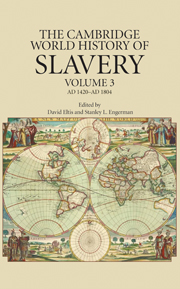Book contents
- Frontmatter
- Contents
- List of Maps, Figures, and Tables
- Contributors
- Series Editors' Introduction
- 1 Dependence, Servility, and Coerced Labor in Time and Space
- PART I SLAVERY IN AFRICA AND ASIA MINOR
- PART II SLAVERY IN ASIA
- PART III SLAVERY AMONG THE INDIGENOUS AMERICANS
- PART IV SLAVERY AND SERFDOM IN EASTERN EUROPE
- 11 Russian Slavery and Serfdom, 1450–1804
- 12 Manorialism and Rural Subjection in East Central Europe, 1500–1800
- PART V SLAVERY IN THE AMERICAS
- PART VI CULTURAL AND DEMOGRAPHIC PATTERNS IN THE AMERICAS
- PART VII LEGAL STRUCTURES, ECONOMICS, AND THE MOVEMENT OF COERCED PEOPLES IN THE ATLANTIC WORLD
- PART VIII SLAVERY AND RESISTANCE
- Index
12 - Manorialism and Rural Subjection in East Central Europe, 1500–1800
from PART IV - SLAVERY AND SERFDOM IN EASTERN EUROPE
Published online by Cambridge University Press: 28 September 2011
- Frontmatter
- Contents
- List of Maps, Figures, and Tables
- Contributors
- Series Editors' Introduction
- 1 Dependence, Servility, and Coerced Labor in Time and Space
- PART I SLAVERY IN AFRICA AND ASIA MINOR
- PART II SLAVERY IN ASIA
- PART III SLAVERY AMONG THE INDIGENOUS AMERICANS
- PART IV SLAVERY AND SERFDOM IN EASTERN EUROPE
- 11 Russian Slavery and Serfdom, 1450–1804
- 12 Manorialism and Rural Subjection in East Central Europe, 1500–1800
- PART V SLAVERY IN THE AMERICAS
- PART VI CULTURAL AND DEMOGRAPHIC PATTERNS IN THE AMERICAS
- PART VII LEGAL STRUCTURES, ECONOMICS, AND THE MOVEMENT OF COERCED PEOPLES IN THE ATLANTIC WORLD
- PART VIII SLAVERY AND RESISTANCE
- Index
Summary
INTRODUCTION
The early modern era was a watershed in the agrarian history of east central Europe. Throughout the fourteenth and fifteenth centuries, most peasants east of the Elbe paid rent or tribute in cash and kind. Then, however, in a process that began slowly in the late fourteenth and fifteenth centuries, and accelerated rapidly after 1500, seigniors embarked on a massive transformation of the agrarian economy, converting their estates into market-oriented manorial economies based on compulsory labor services they were able to impose on their village subjects. Among the seigniors were territorial princes, ecclesiastical property owners, urban corporations, and the landed nobility. After 1500, the latter played the dominant role in establishing both the manorial economy and the harsh forms of rural subjection that accompanied it.
After more than a century of research, the agrarian transformation in east central Europe remains a controversial theme in European history. Manorialism and rural subjection (often termed “the second serfdom”) in the lands of east central Europe developed in vivid contrast to the West, where the manorial economy and its strict forms of rural subjection had largely disappeared by the late Middle Ages.
Many scholars have seized on these divergent paths of agrarian development as the primary explanation for east central Europe's relative backwardness. Robert Brenner, for example, expresses this view when he argues that the second serfdom destroyed the possibility of balanced economic growth and thus consigned the region “to backwardness for centuries.”
- Type
- Chapter
- Information
- The Cambridge World History of Slavery , pp. 297 - 322Publisher: Cambridge University PressPrint publication year: 2011

